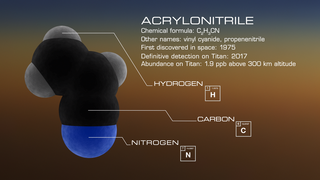Building Blocks for Surviving Titan

Saturn’s moon, Titan, may have a building block for potential cell membranes.
Saturn’s moon, Titan, is hiding a chemical on its surface which has the possibility of creating the basis for life. Acrylonitrile is unique as it is an ingredient that can form structures similar to cell membranes, but it's tough enough to survive Titan's harsh conditions. Using data collected by the Atacama Large Millimeter/submillimeter Array (ALMA) in Chile, NASA researchers identified the fingerprint of acrylonitrile in Titan's upper atmosphere. They believe that it has rained out onto the surface of Saturn as well, collecting in Titan's hydrocarbon lakes. Scientists speculate that in abundance, acrylonitrile can create a stable, spherical membrane that can foster life and protect it against Titan’s freezing surface. The findings expand our understanding of the chemical complexity of the solar system and the potential for life in the universe. Watch the video to learn more.
Learn what NASA scientists' discovery of one chemical on Titan means for life in the solar system.

Acrylonitrile is a molecule that can form spherical membranes that could protect life from Titan's environment.

Titan lakes may contain acrylonitrile that rains out of the atmosphere. Ligeia Mare above is as large as Lakes Huron and Michigan combined.

Titan is an icy moon with hydrocarbon lakes (dark spots) near the north pole and clouds made of methane.

Titan is Saturn's largest moon and the second largest moon in the solar system.
For More Information
See NASA.gov
Credits
Please give credit for this item to:
NASA's Scientific Visualization Studio
Titan images courtesy of NASA/JPL-Caltech/Space Science Institute:
Titan Up Front
Vast Ligeia Mare in False Color
Northern Summer on Titan
Colorful Colossuses and Changing Hues
-
Animators
- Lisa Poje (USRA)
- Michael Lentz (USRA)
-
Producer
- David Ladd (USRA)
-
Scientists
- Conor Nixon (NASA/GSFC)
- Maureen Palmer (Science Collaborator)
- Martin Cordiner (Catholic University of America)
-
Writer
- Gary Crisostomo (Student, University of Maryland College Park)
Release date
This page was originally published on Monday, June 4, 2018.
This page was last updated on Sunday, January 12, 2025 at 11:15 PM EST.
